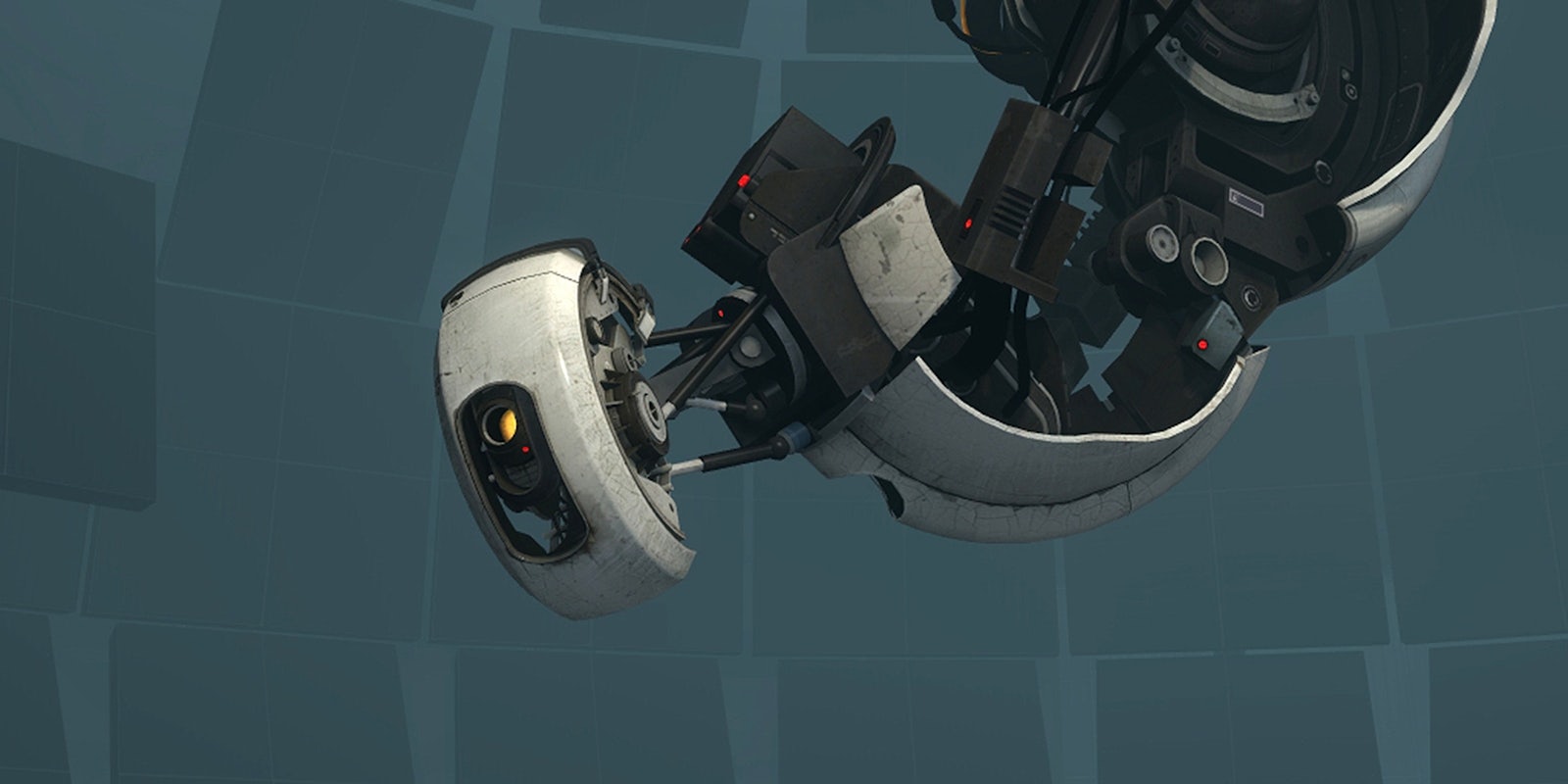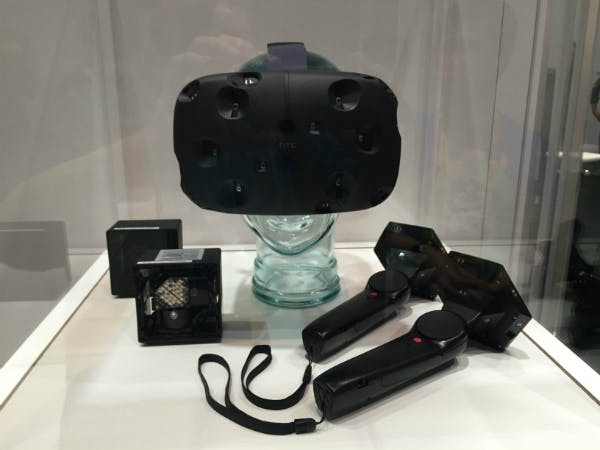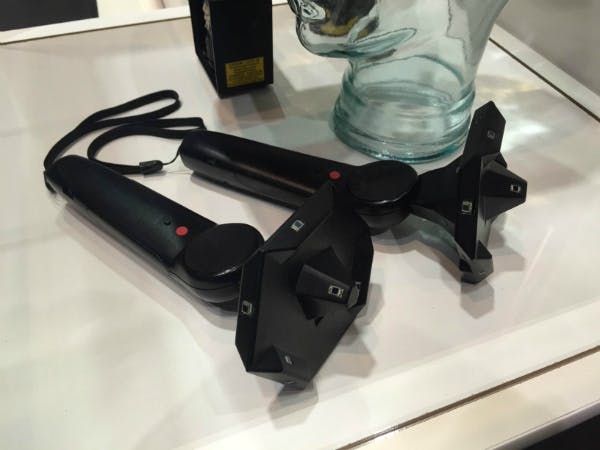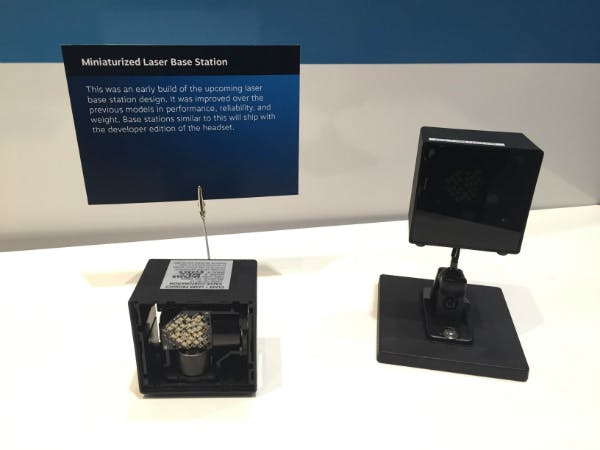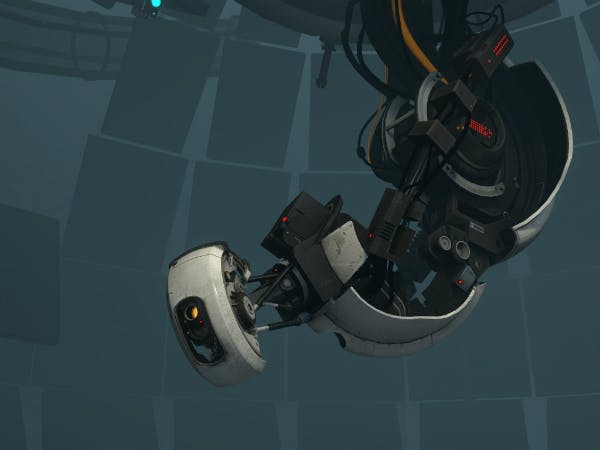I was in a room with GLaDOS today, and it was freaky.
You remember GLaDOS, right? The emotionless, malevolent artificial intelligence from the Portal video game series who hangs from the ceiling on a robotic arm, dangling like a spider from its web, an alien presence whose modulated voice inspires dread.
I wasn’t seeing her on a television screen or a computer monitor, like I had countless times while playing the Portal games. I was standing on my feet, in a room, looking up into what served as her face. It was the most compelling virtual reality experience I’ve had, ever since the Oculus Rift made its first appearance three years ago.
I took a few steps back and watched her body shift and move as she calmly berated me for my uselessness. I knew nothing was going to happen to me. After all, it was just a VR demo.
I still took another step back, though. Some virtual reality demos put the player face-to-face with a shark. Give me a VR speargun, and I can handle a VR shark. But GLaDOS? She’s way too much of a badass.
After my demo of the new SteamVR system, I’m not so skeptical of the current virtual reality craze in gaming.
In Valve Software’s demo space at the 2015 Game Developers Conference I was shown into a large room with white carpet and white walls. At opposite corners of the room were tall, thin bookcases, and atop each bookcase was a little black box that looked like one of the speakers you’d find at the rear of a surround sound system.
Those boxes were actually transmitters for the Lighthouse virtual reality system, bombarding the room with lasers that would be picked up by tiny sensors placed all around the Valve/HTC Vive virtual reality rig I was about to try for the first time. The Lighthouse system allows for precision position tracking of whoever is wearing the Vive, which allows the user to walk around in the real world in order to walk around in a virtual world.
To put it another way, the Lighthouse system makes the holodeck from Star Trek one step closer to a real thing.
The final version of the Vive will only have a single wire running from the Vive and into a PC. My test unit had a bundle of wires running down to a connection in the floor, and I had to put on a harness to make sure I didn’t trip over on the wires as I moved around. The final version of the controllers, thin sticks with a flat, black hexagon at the tip will be wireless, unlike my test unit.
The retail version of the Vive will also have integrated sound rather than the pair of headphones an employee from Valve put over my head, once the Vive rig was situated over my face.
The first thing I noticed once I was strapped into the Vive was that my eyeglasses weren’t getting mashed up against my eyes, as had been the case with every Oculus Rift demo I’ve ever been given. Valve could still stand to add another half an inch of depth to the eye well, but I wasn’t uncomfortable.
Unless virtual-reality headgear is someday made to be light as air or the need for hardware is entirely eliminated somehow, the gear will always be a barrier to complete immersion.
But I honestly could have cared less about feeling the headset or the earphones or the controllers during my Steam VR demo. I finally had a sense of place, the mysterious thing called presence that Oculus Rift developers have been talking about for a year, throughout every portion of the demo.
I was standing on the deck of a ruined ship at the bottom of the ocean. Little fish swam in schools around me, flitting away as I reached up to touch them. I didn’t have to think about relating the position of my hands in the real world, to the position of my virtual hands in the simulation.
Sun beams cut through the water, and I could just perceive the clouds above the surface. “Turn around,” the Valve employee told me.
It was a humpbacked whale, inspecting me the same way I was inspecting him, only where I was gawking at the whale he was calm and serene, floating so close that his giant eyeball was only inches from my face. I felt some relief as he swam away, even though I know humpbacks are gentle creatures. I don’t think a human being can be that close to an animal so huge, with such intelligence in its eyes, and not feel at least a little uncomfortable.
Next, I was standing in a small kitchen, in a world defined in cartoon-style art. When I pulled the triggers on the controllers to grasp an object, I saw disembodied hands floating in the air in front of me. I hope SteamVR games don’t do this very often. I hadn’t needed a prompt to show me where my hands were during the underwater demo. I don’t think I would have needed them in the kitchen, either.
My job was to make soup and a sandwich. The eggs and hot sauce and bread were laid out on a counter in front of me. I had to go into a refrigerator to get the meat for the sandwich. The fridge opened up when I reached out in its direction, and that’s something else I didn’t like. I wanted to grab the handle and open the fridge myself.
I threw some cookbooks out of my way, tossed a knife into the wall, and broke some eggs while finishing the two dishes, laying them on a counter and ringing a bell to summon a server to take the plated food away.
Some of the demos were passive, like standing in a projection of the city of San Francisco. I could pick out the Moscone Center where, in the real world, my Valve demo was taking place. I admired the Alps and walked in a circle around the Earth, hanging in the star-filled heavens, while looking back over my shoulder to watch the Sun.
Some of the demos were no more complicated than choosing colors from a palate in my left hand and scribbling with a thin brush right on the air in front of my face. The Valve employee laughed as I drew a Batman sigil, and colored it in with scribbles of black, and yellow. “You can see that from the other side, by the way,” he said.
I walked around to the other side, seeing my air graffiti in profile for a moment, just a thin sliver of black and yellow and grey, before I was standing behind the Batman sigil I’d just drawn. I got out my virtual palate and virtual paint brush and colored in the spots I’d missed.
In all of these demos, regardless of how simple or how complex, I was there. Standing on San Francisco, like Godzilla. Under the ocean. I was aware of the headset and the controllers. I knew I was occupying real space and virtual space. I could see the grid that marked the edges of the simulation, i.e. the walls of the demo room. But none of these things made the sense of being in virtual spaces any less real.
The last demo began in an office in Aperture Science laboratories, from the Portal series. The aesthetics of Apeture are instantly recognizable, even comfortable, to fans of the Portal games.
The office was kind of grungy, filled with technology that looked like something between 1950s sci-fi pulp and modern-day industrial design. A blue and orange holographic display spun above a metal plate on a workbench. A disembodied voice told me to open one of the drawers on the wall.
Inside the drawer was a miniature office, with thickly drawn stick figures, and a few Portal turrets behind the desks. I don’t remember what I did to make the stick figures panic and run away, but I was told by the disembodied voice to close the drawer. Inside another drawer I found cake.
Finally, I was told to face a thick, metal door that opened up, and in walked an ATLAS model robot from Portal 2’s cooperative mode. The towering robot was broken, sparks flying from exposed wiring.
I took a step back when the sparks began to fly. The reaction was instinctual. I felt a little embarrassed, like I’d finally been taken, hook, line, and sinker, by one of the illusions presented to me by SteamVR.
Then the disembodied voice told me to fix the robot. The innards of the ATLAS’s main body extended out in a cylinder in front of me, divided up into rings of circuit boards and hardware components that I was meant to rotate and push and pull or something. I had no idea what I was doing. Sure enough, the robot fell apart.
The floor tiles underneath the broken ATLAS and the walls in front of me all slid away. The broken robot dropped into the dark bowels of Aperture Laboratories with rows of steel girders that vanished as they descended into the murky depths. I looked down over the edge, thought better of it, and took a step back. Hook, line, and sinker.
I wish I’d tried to step over that looming chasm, just to see what happened, to see how Valve had accounted for someone pushing the boundaries of their VR demo by doing something clearly suicidal. Instead, I looked around the office some more, studying the blue and orange hologram on the workbench until I heard the voice of GLaDOS for the very first time, admonishing me for not being very good at repairing robots.
I turned around and there she was. We were eye-to-eye. I shuddered, only for a moment, catching myself quickly and reminding myself that the space was only virtual. I still took another step back, looking up at the huge robotic armature that is GLaDOS’s body, and I kind of didn’t want to be in the room with her anymore.
Then I wasn’t. The demo was over.
Valve has come as close to mastering virtual technology as I’ve seen yet. The headset doesn’t weigh too much and the controllers were precision input devices. The positional tracking is just as precise.
I want SteamVR in my house. I’ve already thought about how I can rearrange the living room. I don’t really care how much it costs or how much trouble I’d get in by rearranging the living room without first consulting my wife. It was in the middle of one of those fantasies that I metaphorically splashed cold water on my face.
I want SteamVR, but what the hell am I going to do with it? It’ll make for a nice conversation piece at Thanksgiving dinner when my parents and my in-laws are in town, strapping a Valve/HTC Vive virtual reality rig over their heads and watching as their minds get blown. Will I then just put the very expensive piece of hardware away until the next uninitiated guest is invited into my home?
What I experienced today was a series of tech demos, a bunch of compelling experiences, but I didn’t actually play any games. There were no scores, no mission goals, no guns, no steering wheels in virtual cars, nothing that even smacked feintly of a traditional video game. As much as I like the alternative experiences being developed by the indie game world—games whose identities as games are hotly debated by gamers—I also want some regular-old games to play on any hardware I buy.
I will likely wait until a healthy selection of SteamVR games designed explicitly for the device are on the market before I sincerely think about purchasing a SteamVR setup. I imagine most consumers, other than the purest tech fetishists, will be doing the same, just like gamers often wait until there are appreciable software libraries before upgrading to next-generation game consoles.
Developers, if they hold true to form, aren’t going to develop games for SteamVR, or Sony’s Project Morpheus, or the Oculus Rift, until the installed user bases are large enough. With all of this competition for the VR space in peoples’ living rooms, the resulting dilution of the market might mean that not enough people are using any one of the three systems in large enough numbers to warrant developers spending their money, and more importantly their time, developing VR games.
Or, with SteamVR rolling out this year, Valve might be able to grab hold of the potential user base for virtual reality and strangle Oculus before it even arrives (at a date yet unknown).
It still comes down to the games, though. Show me the games. Without them, Steam’s VR rig might just be a paperweight.
But I’ll still want one.
Image via Valve

